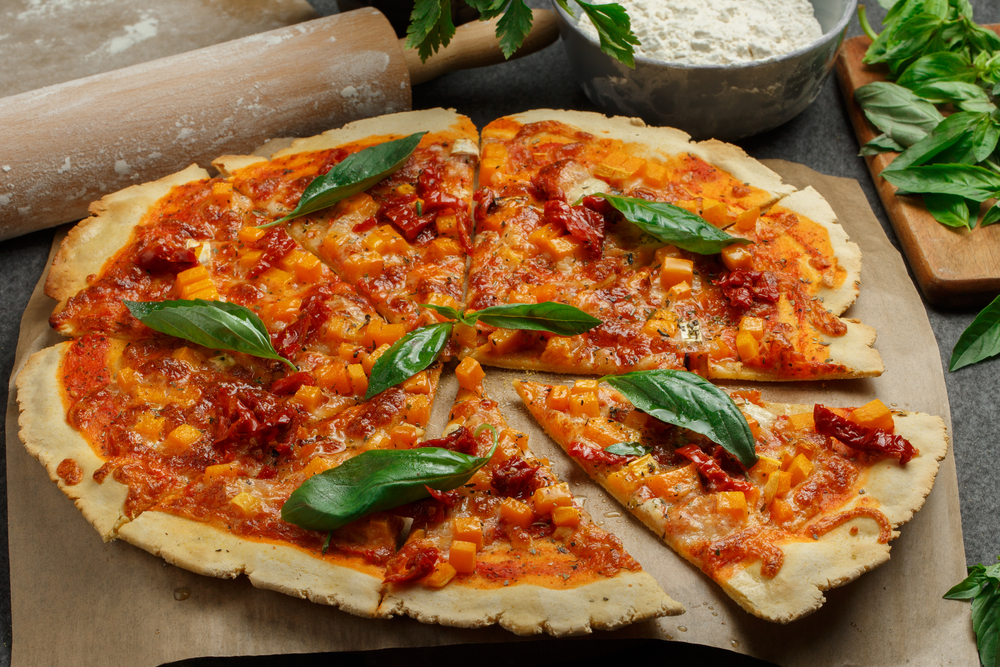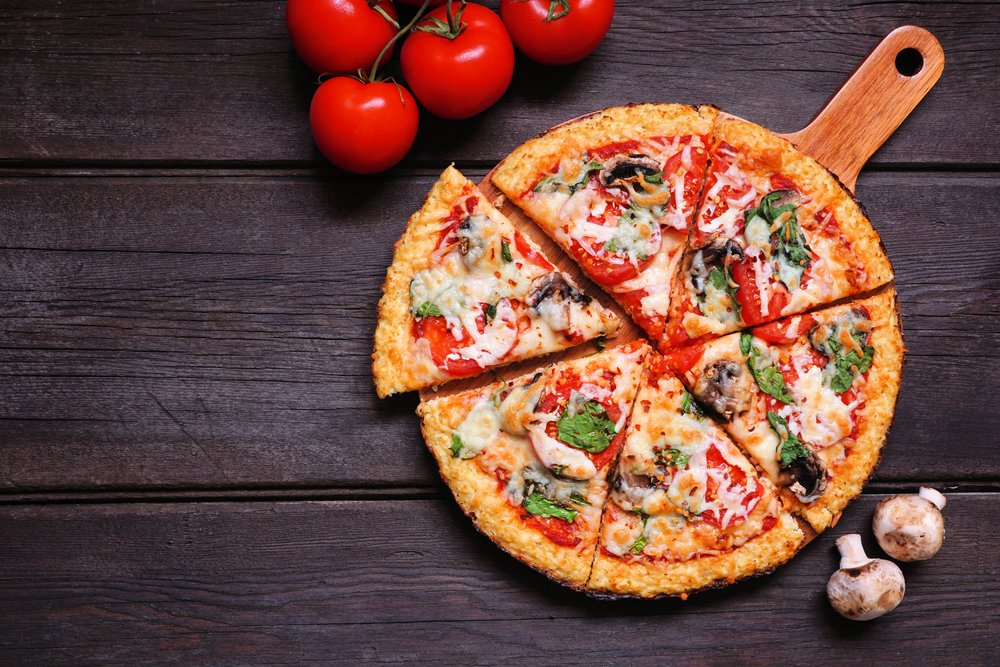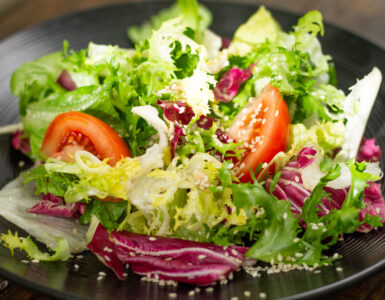Finding a pizza that is suitable for those of us with celiac disease or gluten intolerance can be really difficult.

Fortunately, the popularity of gluten-free pizza has made it feasible for us to eat this popular food without worrying about ingesting gluten. However, what precisely is gluten-free pizza and how is it unique from conventional pizza?
Simply put, gluten-free pizza is pizza made without any gluten-containing components. People with celiac disease or gluten sensitivity may experience severe reactions to gluten, a kind of protein present in wheat, barley, and rye.
As a result, alternative flours such rice flour, cornmeal, or almond flour are frequently used to make gluten-free pizza crusts. The toppings can be anything from the traditional tomato sauce and mozzarella cheese to more unusual pairings like pesto and roasted veggies.
Although gluten-free pizza has advanced significantly in recent years, it’s crucial to remember that not all gluten-free pizzas are the same. Some might be produced in facilities where gluten-containing foods are also processed, which could result in cross-contamination.
To make up for the absence of gluten, certain gluten-free crusts could also have increased amounts of sugar, salt, or fat. As with any cuisine, reading labels carefully and using high-quality ingredients can help to make your gluten-free pizza as wholesome and mouthwatering as possible.
What is Gluten-Free Pizza?
When it comes to pizza, many people assume that it is not an option for those who follow a gluten-free diet.

However, gluten-free pizza is becoming more and more popular, and it is a great option for those who cannot consume gluten. In this section, we will discuss what gluten-free pizza is, its definition, and the different types of gluten-free pizza crust.
Definition of Gluten-Free
Gluten is a protein found in wheat, barley, rye, and other grains. For those with celiac disease or gluten sensitivity, consuming gluten can cause a range of negative symptoms, including gastrointestinal distress, fatigue, and headaches.
Gluten-free pizza is made without any ingredients that contain gluten, making it safe for those with celiac disease or gluten sensitivity to consume.
Gluten-Free Pizza Crust
The crust is the foundation of any pizza, and gluten-free pizza crust is no exception. There are several different types of gluten-free pizza crust, each made from different ingredients. Some of the most common gluten-free pizza crusts include:
- Rice Flour: Rice flour is a popular choice for gluten-free pizza crust because it is easy to work with and has a mild flavor.
- Tapioca Flour: Tapioca flour is often used in combination with other gluten-free flours to create a chewy, elastic crust.
- Almond Flour: Almond flour is a great option for those who are looking for a gluten-free pizza crust that is high in protein and healthy fats.
- Cauliflower Crust: Cauliflower crust is a newer type of gluten-free pizza crust that has become increasingly popular in recent years. It is made from cauliflower rice, cheese, and eggs, and is a low-carb, gluten-free option.
Overall, gluten-free pizza is a great option for those who cannot consume gluten. With a variety of crust options available, there is a gluten-free pizza for everyone.
Gluten-Free Pizza Toppings
When it comes to gluten-free pizza, the toppings are just as important as the crust. Fortunately, there are plenty of delicious options available that are safe for those with gluten sensitivities.
In this section, we’ll explore some of the best gluten-free pizza toppings and how to use them to create a mouth-watering pizza.
Cheese
Cheese is a classic pizza topping that adds flavor and texture to any pie. For those who are lactose intolerant, there are many dairy-free cheese options available that are also gluten-free. Some of the most popular cheese options for gluten-free pizza include:
- Mozzarella
- Cheddar
- Feta
- Goat Cheese
Meat Toppings
Meat toppings are a great way to add protein and flavor to your gluten-free pizza. When it comes to gluten-free meat toppings, there are plenty of options to choose from. Some of the most popular gluten-free meat toppings include:
- Pepperoni
- Sausage
- Bacon
- BBQ Chicken
Vegetable Toppings
Vegetable toppings are a healthy and delicious way to add flavor and nutrition to your gluten-free pizza. Some of the most popular gluten-free vegetable toppings include:
- Onions
- Mushrooms
- Bell Peppers
- Tomatoes
- Olives
Sauce
The sauce is the foundation of any pizza, and there are many gluten-free sauce options available. Some of the most popular gluten-free pizza sauces include:
- Tomato Sauce
- Pesto
- Alfredo Sauce
- BBQ Sauce
Overall, there are plenty of delicious gluten-free pizza topping options available. Whether you prefer meat, vegetables, or cheese, there are many ways to create a delicious gluten-free pizza that everyone will love.
Gluten-Free Pizza Taste
When it comes to gluten-free pizza, taste is always a concern. However, with the right ingredients and preparation, gluten-free pizza can be just as delicious as its gluten-containing counterpart. In this section, we’ll explore the different tastes and textures of gluten-free pizza.
Thin and Crispy
Thin and crispy crusts are a popular choice for gluten-free pizza. These crusts are typically made with alternative flours such as rice flour, sorghum flour, and potato starch, along with xanthan gum to help bind the dough together. The result is a crispy crust that can hold up to toppings without getting soggy.
Small and Delicious
Another popular option for gluten-free pizza is small, personal-sized pizzas. These pizzas are often made with cauliflower crusts, which are lower in carbs and higher in fiber than traditional pizza crusts.
Cauliflower crusts can be made with a combination of cauliflower rice, cheese, and eggs, or with alternative flours such as tapioca starch and brown rice flour.
Alternative Flours
Alternative flours are a key ingredient in gluten-free pizza crusts. In addition to rice flour, sorghum flour, and potato starch, other alternative flours that can be used include almond flour, coconut flour, and chickpea flour.
Each of these flours has a unique taste and texture, and can be used alone or in combination with other flours to create a delicious gluten-free pizza crust.
Overall, gluten-free pizza can be just as tasty as traditional pizza if the right ingredients and preparation methods are used. Whether you prefer a thin and crispy crust or a small and delicious personal-sized pizza, there are plenty of options available for those who need or choose to avoid gluten.
Gluten-Free Pizza and Gluten Sensitivity
When it comes to gluten-free pizza, it’s important to understand the relationship between gluten sensitivity and the ingredients used in the pizza crust.
Gluten sensitivity is a condition where people experience adverse reactions to gluten, a protein found in wheat, barley, and rye. This condition can range from mild discomfort to severe symptoms such as diarrhea, abdominal pain, and fatigue.
For people with gluten sensitivity, a gluten-free diet is often recommended. This means that they need to avoid foods that contain gluten, including pizza crusts made from wheat flour. Fortunately, there are many gluten-free pizza crust options available that use alternative flours such as corn, rice, or even cauliflower.
It’s important to note that gluten-free pizza is not just for people with gluten sensitivity. Those with celiac disease, a genetic autoimmune disorder that damages the small intestine when gluten is ingested, must also follow a gluten-free diet.
In fact, even a small amount of gluten can cause damage to the small intestine in people with celiac disease.
When it comes to making gluten-free pizza crusts, there are many ingredients that can be used as substitutes for wheat flour. Some of these include corn, rice, and potato flour, as well as tapioca and arrowroot starch. Xanthan gum is often added to gluten-free pizza crusts to mimic the elasticity of gluten.
It’s important to note that just because a pizza crust is gluten-free, it doesn’t mean it’s automatically healthy.
Some gluten-free pizza crusts may contain higher amounts of sugar or fat to compensate for the lack of gluten. As with any food, it’s important to read labels and choose gluten-free pizza crusts that are made with whole, nutritious ingredients.
Gluten-Free Pizza in Restaurants
When it comes to dining out, finding gluten-free options can be a challenge. However, many restaurants now offer gluten-free pizza to cater to their gluten-sensitive customers. In this section, we will discuss some of the popular gluten-free pizza chains and how to order gluten-free pizza.
Gluten-Free Pizza Chains
Several pizza chains have added gluten-free pizza to their menus. California Pizza Kitchen offers a gluten-free crust made with cauliflower, while Domino’s has a gluten-free crust made with rice flour, potato starch, and tapioca starch.
Papa John’s also offers a gluten-free crust made with sorghum, teff, amaranth, and quinoa.
Ordering Gluten-Free Pizza
When ordering gluten-free pizza, it is important to communicate your needs clearly to the restaurant staff. Ask about the ingredients in the crust and sauce to ensure they are gluten-free.
Some restaurants may use separate utensils and cooking surfaces to avoid cross-contamination, while others may not. It is also important to note that while the crust may be gluten-free, the toppings may not be, so be sure to ask about those as well.
If you have celiac disease or a severe gluten allergy, it may be best to avoid pizza restaurants altogether and opt for frozen gluten-free pizza instead. Brands like Caulipower, DiGiorno, and Freschetta offer frozen gluten-free pizza options that can be cooked at home.
When ordering gluten-free pizza, it is important to communicate your needs clearly and ask about the ingredients and cooking process. If you have celiac disease or a severe gluten allergy, it may be best to opt for frozen gluten-free pizza instead.
Conclusion
We hope this article has provided you with a clear understanding of what gluten-free pizza is and how it can be a great option for those with celiac disease or gluten intolerance. By using gluten-free flour, such as rice flour or potato starch, pizza makers can create a crust that is safe for consumption by those with gluten sensitivity.
Gluten-free pizza can also be a great option for those looking to maintain a gluten-free lifestyle, as it can be a delicious substitute for traditional pizza.
When making a gluten-free pizza, it is important to be mindful of the ingredients used in the crust and toppings. Opt for whole food ingredients like beans and vegetables, and be wary of added sugars and salts.
For those looking to lose weight, gluten-free pizza can be a good option as it is often lower in calories than traditional pizza. However, it is important to note that gluten-free pizza should not be relied on as a sole means of weight loss, and should be consumed in moderation as part of a balanced diet.
When selecting a gluten-free frozen pizza, be sure to read the label carefully to ensure that it is truly gluten-free and does not contain any hidden sources of gluten.
Cheese pizza is a popular option for those with celiac disease or gluten intolerance, but it is important to note that not all cheese is gluten-free. Be sure to check the label or ask your pizza maker before consuming.










Add comment